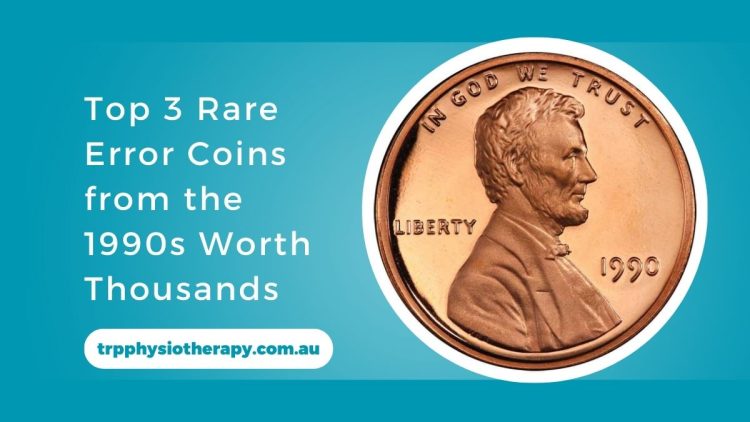The 1990s produced several remarkable error coins that have captivated collectors and fetched impressive sums at auctions.
These anomalies, resulting from minting mishaps, are rare and highly sought after. Below, we delve into three standout error coins from the 1990s that could be hiding in plain sight, waiting to be discovered.
1. 1990 No-S Proof Lincoln Cent
One of the most intriguing errors of the decade is the 1990 No-S Proof Lincoln Cent. Traditionally, proof coins minted in San Francisco bear the ‘S’ mint mark.
However, a small batch of 1990 proof cents was mistakenly struck without this designation. It’s estimated that fewer than 200 of these coins exist today, making them exceptionally rare.
Key Features:
- Minting Error: Absence of the ‘S’ mint mark on a proof coin.
- Identification: Mirror-like finish typical of proof coins, coupled with the missing mint mark.
- Value: Depending on condition, these coins can command prices ranging from $3,000 to over $6,000.
2. 1999 Wide “AM” Reverse Lincoln Cent
Another notable error is the 1999 Wide “AM” Reverse Lincoln Cent. In standard 1999 Lincoln cents, the letters ‘A’ and ‘M’ in “AMERICA” on the reverse are closely spaced.
However, some coins were mistakenly struck with a wider gap between these letters, using a reverse design intended for proof coins.
Key Features:
- Minting Error: Unintended wide spacing between the ‘A’ and ‘M’ in “AMERICA” on the reverse.
- Identification: Examine the spacing between ‘A’ and ‘M’ in “AMERICA”; a noticeable gap indicates the error.
- Value: High-grade examples of this error coin have been known to sell for several thousand dollars.
3. 1992 Close “AM” Reverse Lincoln Cent
The 1992 Close “AM” Reverse Lincoln Cent presents an intriguing anomaly. In standard 1992 cents, the letters ‘A’ and ‘M’ in “AMERICA” are spaced apart. However, some coins were mistakenly struck with the letters nearly touching, a design intended for 1993 cents.
Key Features:
- Minting Error: Reduced spacing between the ‘A’ and ‘M’ in “AMERICA” on the reverse.
- Identification: Observe the reverse lettering; if ‘A’ and ‘M’ are almost touching, it indicates the error.
- Value: Depending on condition, these coins can fetch anywhere from $1,000 to $25,000.
Summary Table
| Coin | Minting Error | Identification | Estimated Value |
|---|---|---|---|
| 1990 No-S Proof Lincoln Cent | Absence of ‘S’ mint mark on proof coin | Mirror-like finish without mint mark | $3,000 – $6,000+ |
| 1999 Wide “AM” Reverse Lincoln Cent | Wide spacing between ‘A’ and ‘M’ in “AMERICA” | Noticeable gap between ‘A’ and ‘M’ on reverse | Several thousand dollars |
| 1992 Close “AM” Reverse Lincoln Cent | Narrow spacing between ‘A’ and ‘M’ in “AMERICA” | ‘A’ and ‘M’ nearly touching on reverse | $1,000 – $25,000 |
The 1990s produced several error coins that have become prized possessions among collectors.
The 1990 No-S Proof Lincoln Cent, 1999 Wide “AM” Reverse Lincoln Cent, and 1992 Close “AM” Reverse Lincoln Cent are standout examples, each with unique characteristics and significant value.
If you’re a coin enthusiast or simply curious, examining your collection or pocket change might lead to the discovery of one of these rare treasures.
FAQs
How can I identify a 1990 No-S Proof Lincoln Cent?
Look for a 1990 Lincoln cent with a mirror-like finish typical of proof coins but lacking the ‘S’ mint mark beneath the date.
What causes the Wide “AM” and Close “AM” errors in Lincoln cents?
These errors result from the use of incorrect reverse dies during the minting process, leading to variations in the spacing of the letters ‘A’ and ‘M’ in “AMERICA.”
Are these error coins still in circulation?
While rare, it’s possible for these coins to be found in circulation. However, many have been identified and collected over the years.
How should I handle and store rare error coins?
Handle coins by their edges to avoid contamination and store them in protective holders to preserve their condition and value.

